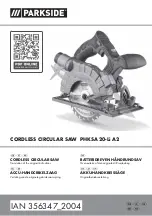
-34-
Model G0568/G0569 (Mfd. Since 10/11)
Tensioning Blade
A properly tensioned blade is essential for making
accurate cuts and is required before making many
bandsaw adjustments. (Everytime you replace the
blade, perform this procedure because all blades
tension differently.)
To tension the bandsaw blade:
1. Complete the Test Run procedure and make
sure the blade is tracking properly (see
Page
25).
2. Raise the upper blade guide assembly as
high as it will go, and adjust the upper and
lower guide blocks as far away from the blade
as possible (see
Adjusting Blade Guide
Bearings).
Note: This procedure will NOT work if the
guide blocks have any contact with the
blade.
3. Move the quick tension lever to the tight-
ened position and turn the blade tension
handwheel until the blade tension matches
the mark on the blade tension scale for the
appropriate blade thickness (See
Figure 28,
Page 25).
4. Turn the bandsaw ON.
5. Slowly release the tension one quarter of a
turn at a time. When you see the bandsaw
blade start to flutter, stop decreasing the
tension.
6. Now, slowly increase the tension until the
blade stops fluttering, then tighten the tension
another quarter turn.
7. Look at what the blade tension scale reads
and use that as a guide for tensioning that
blade in the future.
Note: Always release blade tension after use
to increase blade life and reduce strain on the
bandsaw components.
8. Re-adjust the blade tracking as instructed on
Page 25.
The blade guides provide side-to-side support to
keep the blade straight while cutting. The blade
guides are designed to be adjusted in two ways—
forward/backward and side-to-side.
To adjust the upper blade guides:
1. Make sure the blade is tracking properly and
that it is correctly tensioned.
2. DISCONNECT BANDSAW FROM POWER!
Adjusting Blade
Guide Bearings
Summary of Contents for G0568
Page 80: ......
















































